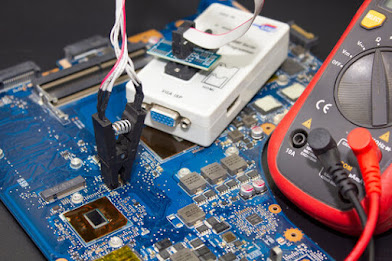Motherboard Chip Level Repair
Introduction: Chip level repair of motherboards is a complex and technical task that requires specialized knowledge and skills. A motherboard is the main circuit board in a computer and contains various components, including microprocessors, memory chips, and other integrated circuits. In this article, we will provide a comprehensive guide for chip level repair of motherboards, including the tools and techniques required.
Understanding the components of a motherboard: Before attempting chip level repair of a motherboard, it is important to understand the various components and their functions. A motherboard typically consists of several layers of printed circuit board (PCB) that contain the various components. These components include microprocessors, memory chips, power management chips, and other integrated circuits. Understanding the function and location of these components is essential for effective troubleshooting and repair.
Troubleshooting and identifying issues at the chip level: Proper troubleshooting is crucial when it comes to chip level repair of motherboards. This includes identifying the specific components that are causing issues and diagnosing the root cause of the problem. This can involve using specialized equipment such as a multimeter, oscilloscope, and logic analyzer to test and measure various signals and voltages. It's also important to consult the schematics and service manual of the motherboard.
Techniques for chip level repair, including soldering and microsoldering: Once the issues have been identified, the next step is to repair the motherboard. This can involve replacing or repairing faulty components, such as microprocessors, memory chips, and other integrated circuits. To do this, a technician will typically use specialized tools such as a soldering iron, hot air gun, and microscope. The process of soldering is used to connect or repair components to the PCB, while microsoldering is a more advanced technique used to repair small and delicate components.
Conclusion and future outlook: Chip level repair of motherboards is a complex and technical task that requires specialized knowledge and skills. By understanding the components of a motherboard, troubleshooting and identifying issues at the chip level, and mastering techniques such as soldering and microsoldering, technicians can effectively repair motherboards and keep them running smoothly. As technology continues to advance, it will be essential for it's also important to note that chip level repair can be a delicate and challenging task and it's highly recommended to have the proper training before attempting this type of repair. There are several certified training programs available online and offline that can teach technicians the skills and knowledge needed to perform chip level repair effectively and safely. By investing in training, technicians can improve their skills, increase their knowledge and build a successful career in the field of chip level repair.
Repairing a motherboard at the chip level requires a high level of technical expertise and precision. The process involves identifying and replacing faulty components on the board, such as chips, transistors, and other electronic components. This type of repair is typically performed by trained professionals with access to specialized tools and equipment. Due to the complexity of the task, it is often more cost-effective to replace the entire motherboard rather than attempt a chip level repair. However, in some cases, a chip level repair may be the only option to restore a device to working condition. It's important to note that attempting a chip level repair without proper training and equipment can result in further damage to the device.
When a chip level repair is necessary, the first step is to diagnose the problem. This may involve using specialized diagnostic tools and software to identify the specific components that are malfunctioning. Once the faulty components have been identified, they must be replaced. This requires a high level of skill and precision, as the components are extremely small and can be easily damaged.
The repair process may also involve re-flowing or re-balling the chips. This is a delicate process in which the solder connections on the chip are melted and re-formed. This can help to fix issues such as cold solder joints, which can occur when the solder doesn't properly adhere to the chip.
Another important aspect of chip level repair is making sure that the replacement components are compatible with the device. This is essential to ensure that the device will function properly once the repair is complete. In some cases, the replacement parts may need to be ordered from the manufacturer or a specialized supplier.
It's important to note that chip level repair is not always a feasible option. In some cases, the damage to the motherboard may be too extensive, or the cost of the repair may outweigh the value of the device. In these situations, it may be more cost-effective to replace the device rather than attempt a repair.
In conclusion, Chip level repair is a complex and delicate process that requires a high level of technical expertise and precision. It's important to consider the cost of the repair, the value of the device, and the availability of replacement parts before attempting a chip level repair. It is often recommended that you should consult a professional technician with the appropriate skills and equipment to carry out the repair.
It's also worth noting that chip level repair is not limited to motherboards. Many other types of electronic devices, such as smartphones, laptops, and gaming consoles, can also require chip level repairs. In these cases, the process may involve replacing components on the logic board or mainboard, which is similar to repairing a motherboard.
In addition, a chip level repair is not always a permanent solution. Over time, the same problem may reoccur due to the same or different reasons. This is why it's important to address the root cause of the problem rather than just fixing the symptoms.
Moreover, It's also important to consider the environmental impact of chip level repair. Electronic devices contain a variety of materials that can be harmful to the environment if not disposed of properly. When a chip level repair is performed, it's important to follow proper disposal guidelines to ensure that the materials used in the repair are recycled or disposed of in an environmentally friendly manner.
In summary, Chip level repair is a complex and delicate process that requires a high level of technical expertise and precision. It's important to consider the cost of the repair, the value of the device, the availability of replacement parts, the possibility of reoccurring problem and the environmental impact before attempting a chip level repair. It is always recommended to consult a professional technician with the appropriate skills and equipment to carry out the repair.







Comments
Post a Comment